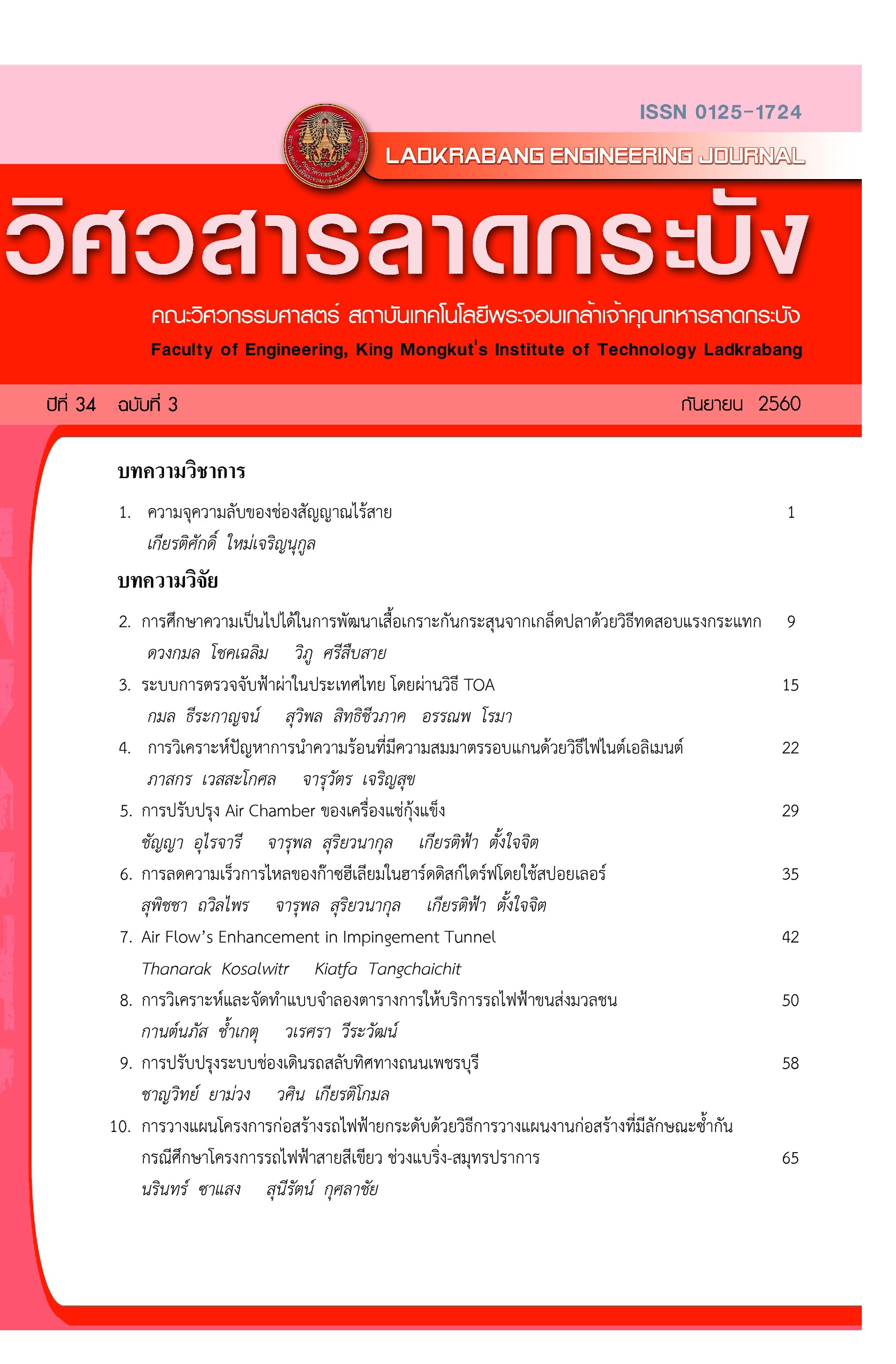Decreasing of Helium Flow Velocity inside Hard Disk Drive by Using Spoiler
Keywords:
Hard Disk Drive, Computational Fluid Dynamics, Helium FlowAbstract
The installation of spoiler that strikes the (Head Gimbals Assembly: HGA) in hard disk drive, that causes a vibration on the HGA and also causes the positioning errors. Filling helium gas in the hard disk drive is helpful for reducing the strikes force on the parts in hard disk drive. In this research, Helium flow in hard disk drive (3.5 inch with 7,200 rpm) is simulated by using ANSYS fluent v.14.5 software. The results show that the velocity profile of the width 25 and length 30 millimeters spoiler is the most suitable one that reduces and divert the helium flow which strikes the HGA. When the flow of the HGA reduces, therefore the vibration will reduce as well.
References
[2] J. Suriyawanakul and K. Tangchaichit, “CFD Investigation of Damper Plate Effect on Air Flow in High Speed Rotation Hard Disk Drive by Using K-E with a Partial Model”, Applied Mechanics and materials, Vol. 392, pp. 85-89, 2013.
[3] W. Kankaew and K. Tangchaichit, “Decreasing Airflow Velocity in High Speed Hard Disk Drive by Using Spoiler”, Advanced Materials Research, Vol. 1061-1062, pp. 862-865, 2015.
[4] I. Sato, K. Otani, S. Oguchi and K. Hoshiya, “Characteristics of heat transfer in a helium-filled disk enclosure.” IEEE Transactions on Advanced Packaging, Vol. 11, pp. 571–575, 1988.
[5] S. W. Kil, J. A. C. Humphrey, H. Haj-Hariri, “Experimental study of the flow-structure interactions in an air- or helium-filled hard disk drive geometry.”, Microsyst Technol, Vol.18, pp. 43–56, 2012.
[6] S. W. Kil, J. A. C. Humphrey, H. Haj-Hariri, “Numerical study of the flow-structure interactions in an air- or helium-filled simulated hard disk drive.”, Microsyst Technol, vol.18, pp. 57–75, 2012.
[7] S. W. Kil, J. A. C. Humphrey, H. Haj-Hariri, “Turbulence intensity inversion induced by the mass-reducing hole in an air or helium filled hard disk drive”, Microsyst Technol , Vol.19, pp.31–42, 2013.
[8] S. W. Kil, J. A. C. Humphrey, H. Haj-Hariri, “Numerical study of the flow-structure interactions in an air- or helium-filled simulated hard disk drive”, Microsystem Technologies, Vol. 18, Issue 1, pp 57–75, January 2012.
[9] Ansys Fluent 14.5, User’s guide, Chapter 4, 2012 Turbulence, October 2012.
[10] Seagate Technology LLC, What is the normal operating temperature for Seagate disk drives? http://knowledge.seagate.com/articles/en_US/FAQ/193771en. (2016) Accessed 16 February 2016
[11] Microelectronics Heat Transfer Laboratory, Fluid Properties Calculator. http://www.mhtl.uwaterloo
.ca/old/onlinetools/airprop/airprop.html. (2016) Accessed 8 February 2016
Downloads
Published
How to Cite
Issue
Section
License
The published articles are copyrighted by the School of Engineering, King Mongkut's Institute of Technology Ladkrabang.
The statements contained in each article in this academic journal are the personal opinions of each author and are not related to King Mongkut's Institute of Technology Ladkrabang and other faculty members in the institute.
Responsibility for all elements of each article belongs to each author; If there are any mistakes, each author is solely responsible for his own articles.






